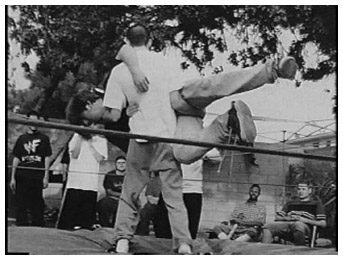


 |


launch interview with Cameron Jamie
Cameron Jamie's work--a blend of video, performance, sculpture, and drawing--deals with American history and culture, in particular their dysfunctional manifestations. Jamie's sharp critical gaze often focuses on popular culture and its impact on everyday life and the psyche. His work exposes the failings of the "American Way" and his methodology is informed by scientific and forensic anthropology. His intricate work has its background in the artist's own folklore and mythologies. Using American suburban culture as a case study, he analyzes how the structures of mythology are shaped and shared and the extent to which they participate in the creation of individuals' fictional worlds, fictional selves.
B B (2000) was filmed after a long investigation of the backyard wrestling phenomenon in southern California. For two years Jamie followed groups of kids in the San Fernando Valley, shooting videos, going to their wrestling shows, and integrating himself into this community. The film itself was shot with two Super-8 cameras and is superimposed with the timeless, demented, slow, and forceful music of the Melvins. The combination of the slow-motion, black-and-white images with this music creates a dreamlike state that reinforces a nightmare quality. The challenge of such a project was to avoid an exploitative relationship to its topic. Jamie is not interested in authoring "arty white-trash chic," or in depicting violence in a traditional documentary way. The dreamlike form of the film takes the documentary format to another level, to what he calls a "purgatory state of being," a middle ground that, in his view, is perfectly embodied in the notion of suburbs.
In a recent project, Jamie documents homes that have been converted by their inhabitants into spook houses, dungeons, and torture chambers. He sees this phenomenon as equivalent to early French Grand Guignol, a theater genre of the late nineteenth century that specialized in productions designed to terrify and sicken through the display of violence and horror. Jamie looks at how such forms of theater are reinterpreted in the social theater of family life located in the American lower- and middle-class suburbs where he grew up. This idea of self-reference is at the center of the Goat Performance project, a one-on-one performance in which Jamie dresses as Dracula and explores the San Fernando Valley in the company of a guest. No photographs or documentation are made. The guest later gives a verbal testimony of the experience, which Jamie transcribes in a text; a hired portrait artist then produces a drawing related to the text.
Jamie has shown his works in a number of group exhibitions, including Legitimate Theater, Los Angeles County Museum of Art, Los Angeles (2001); Try This On, Yerba Buena Center for the Arts, San Francisco, California (2001); and Let's Entertain/Au-délà du spectacle, Musée national d'art moderne, Centre Georges Pompidou, Paris, France (2000-2001). He has had solo exhibitions at the Chantal Crousel Gallery, Paris (2002), and the Centre national de l'estampe et de l'art imprimé, Chatou, France (2001).
--Philippe Vergne











